Soft, tender and fluffy Sourdough Pita Bread for all the sandwich stuffings like these Greek Pita Sandwiches, and a vehicle for scooping up flavorful dips and spreads like Artichoke Hummus. Use your doubled in size Sourdough Starter to whip up this sourdough pita recipe. This recipe is vegetarian and vegan friendly.
⭐️⭐️⭐️⭐️⭐️ Review: “I’ve tried making sourdough pita bread about 3 times using a variety of recipes. None of them could compare to the texture and flavor of your recipe.” ~ Marisa
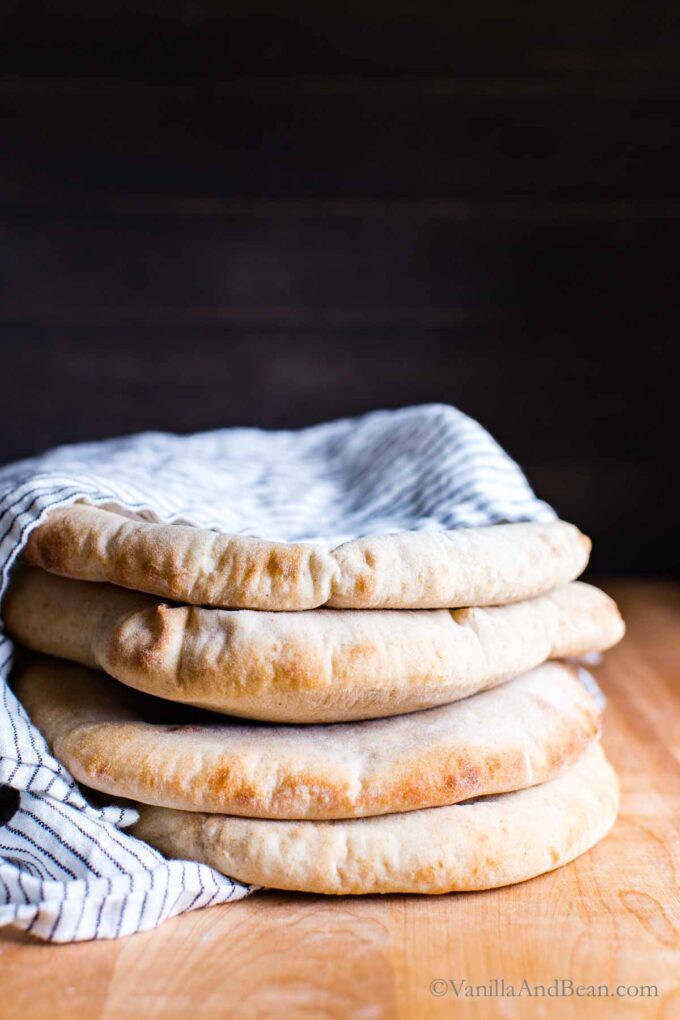
Table of Contents
Homemade Sourdough Pita Bread
If you love Sourdough Recieps, you’re going to love this Sourdough Pita Bread recipe. Homemade pita bread is flavorful, tender, soft and fun to make; It’s my best sourdough pita recipe! Watching it puff up in the oven means homemade pita isn’t too far away (and it’s so satisfying!).
Here’s why you’ll enjoy this sourdough pita recipe:
- easy to make
- simple ingredients
- freezer friendly
- versatile enough for sandwiches, rich soups, pita pizza or slicing into wedges for dipping
There are many ways to enjoy homemade pita bread, and it tastes amazing! Read on to learn more.
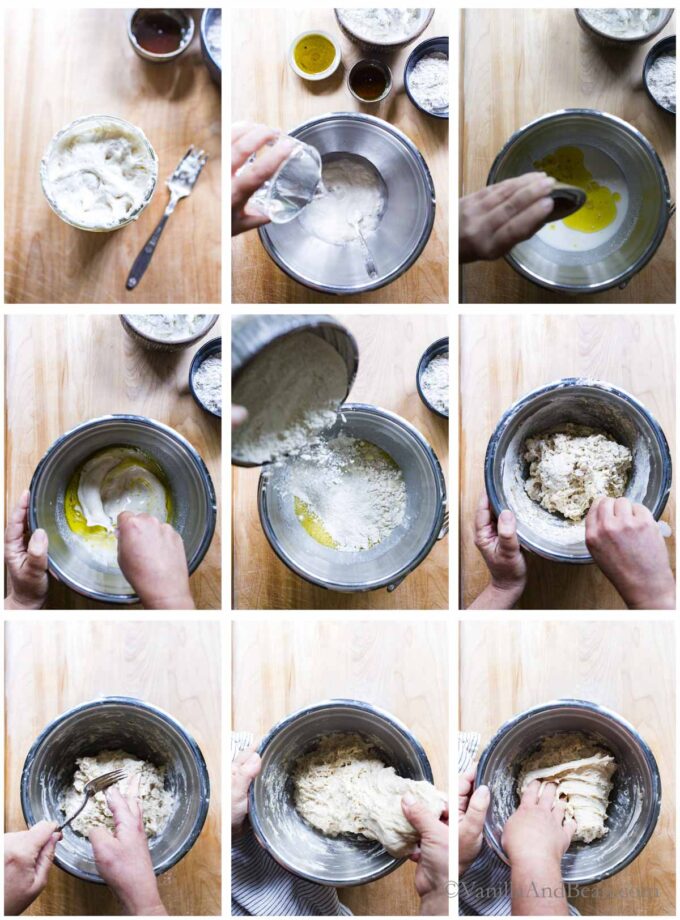
Ingredients You’ll Need for Sourdough Pita
- Sourdough Bread Starter – previously feed, doubled in size
- Bread Flour – unbleached, organic if possible
- Whole Wheat Flour – you can use whole wheat bread flour or regular whole wheat. Look for stone ground, I like Bob’s Red Mill.
- Maple Syrup or Honey – just a bit to balance flavors
- Olive Oil – to soften and flavor the pita bread
If you have leftover sourdough starter, use it in my Olive Oil Sourdough Discard Crackers.
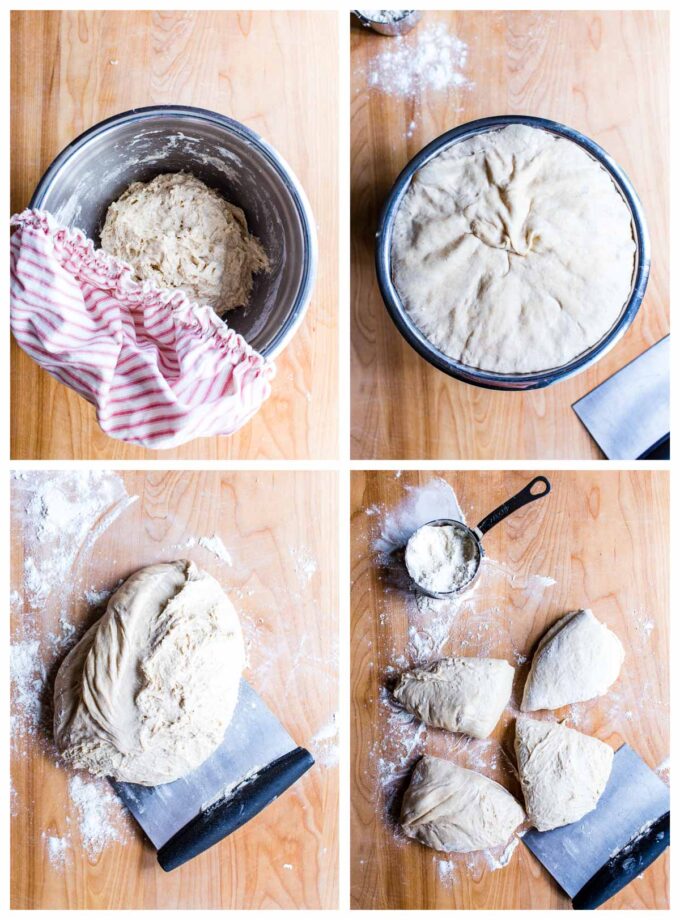
Quick Guide: How to Make Sourdough Pita Bread
You’ll start with a 100% hydration, doubled in size Sourdough Starter. Just like making sourdough bread, plan ahead so the dough has plenty of time to rise. In summary, here’s how to make pita bread (see recipe card for details):
- First, in a medium mixing bowl, add your fluffy and active sourdough starter.
- Second, stir in warm water, maple syrup and oil.
- Third, add the bread flour, whole wheat and salt.
- Fourth, mix the dough by hand until no dry patches remain.
- Next, bulk ferment at room temperature overnight for about 12-16 hours.
- Last, shape the dough, proof for just 15 minutes, then use a rolling pin to roll out each individual pita and bake!
To bake the sourdough pita, you’ll use the back of a baking sheet or pizza stone / baking stone. Use parchment paper cut to fit individual pita dough to make transferring the pita rounds to the baking surface easier. You’ll bake for just 5-6 minutes, then wrap the hot pita in a kitchen towel.
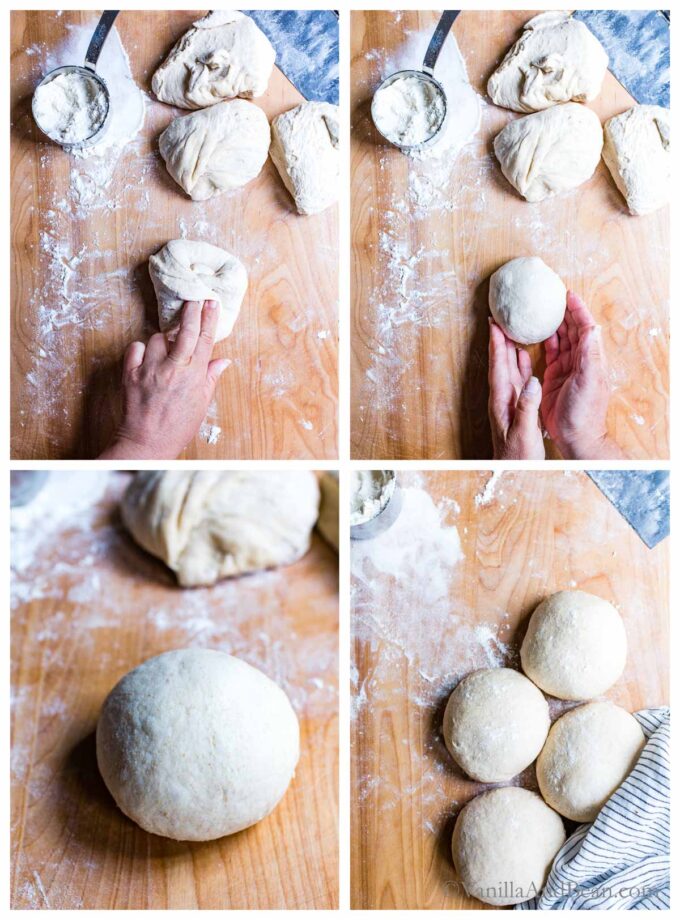
Things to Stuff, Slather, Dip or Serve with Sourdough Pita Bread
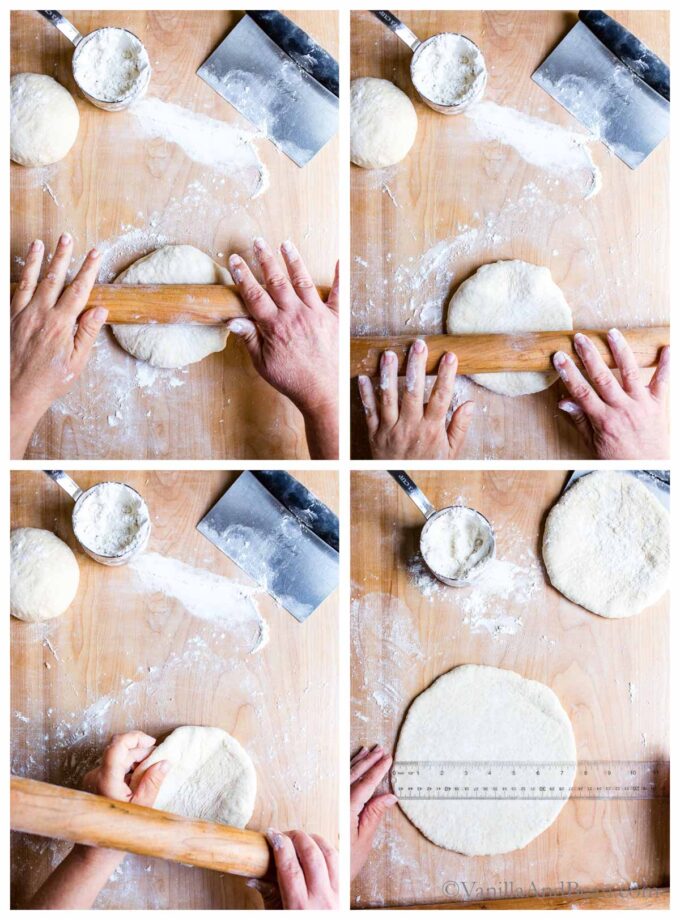
Sourdough Pita Bread FAQs
What Makes Pita Bread Puff Up?
Pita is baked at a high temperature, in this case, in the oven at 500 degrees Fahrenheit. When the dough hits the hot baking surface, the water quickly becomes steam, causing the pita to puff up. When removed from the oven, the void or “pocket” remains.
What Country Does Pita Bread Originate?
Pita has its roots in the Middle East, dating back 14,500 years! According to Wikipedia, Pita originates from the Natufian people in Jordan.
Should Pita Bread be Heated in the Oven?
To reheat pita in the oven, wrap it in foil to retain its soft texture.
Can You Use Pita Bread as a Pizza Base?
Yes, and it’s delicious! Preheat your oven and a pizza stone or upside-down baking pan to 500 – 550 degrees Fahrenheit. Top your pita with your favorite pizza toppings. Slide it onto a piece of parchment paper, then use the parchment as a handle to slide it onto the preheated baking pan/stone. Bake for about five to six minutes, then it’s ready!
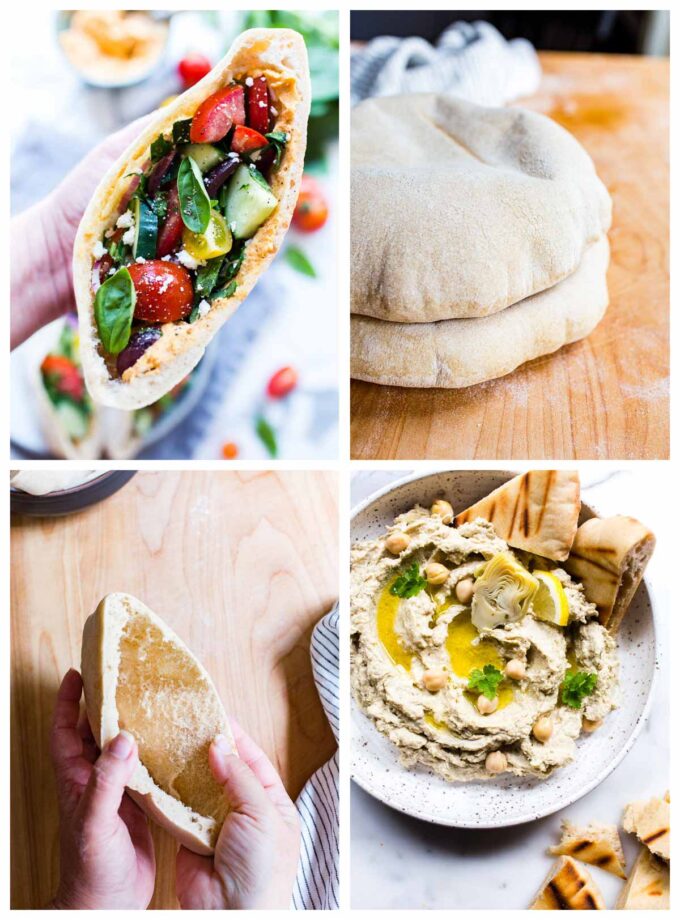
Sourdough Pita Making Timeline
- In the Morning: Feed your starter and allow it to double in size.
- In the Evening: Mix the dough and bulk ferment at room temp.
- The Next Morning: shape, rest and bake.
Pita Making Tools
You’ll need a few basic bread baking tools. Here are some of my favorite tools (these are affiliate links):
- Digital Scale – accurately weighs your ingredients for optimal outcome.
- Baking Stone – evenly transfers heat to your pita dough in the oven and also, it’s an ideal base for making sourdough pizza crust too!
- Rolling Pin – used to roll the pita dough evenly and thin.
- Aluminum Sheet Pan – an ideal baking medium if you don’t have a baking stone on hand. I find it works just as effectively as a baking stone! Turn it upside down for easy pita dough transfer.
- Parchment Paper – a perfect vehicle for transferring the rolled out pita dough into the oven and onto your baking surface.
- Bench Scraper – scrapes all the bits of flour and dough off your work surface to keep it clean and tidy.
- Kitchen Tools: I recommend a digital oven thermometer with an air probe. Knowing the accurate temperature of your oven allows you to make temperature adjustments when needed. Weigh your ingredients using a digital kitchen scale for the best outcome.
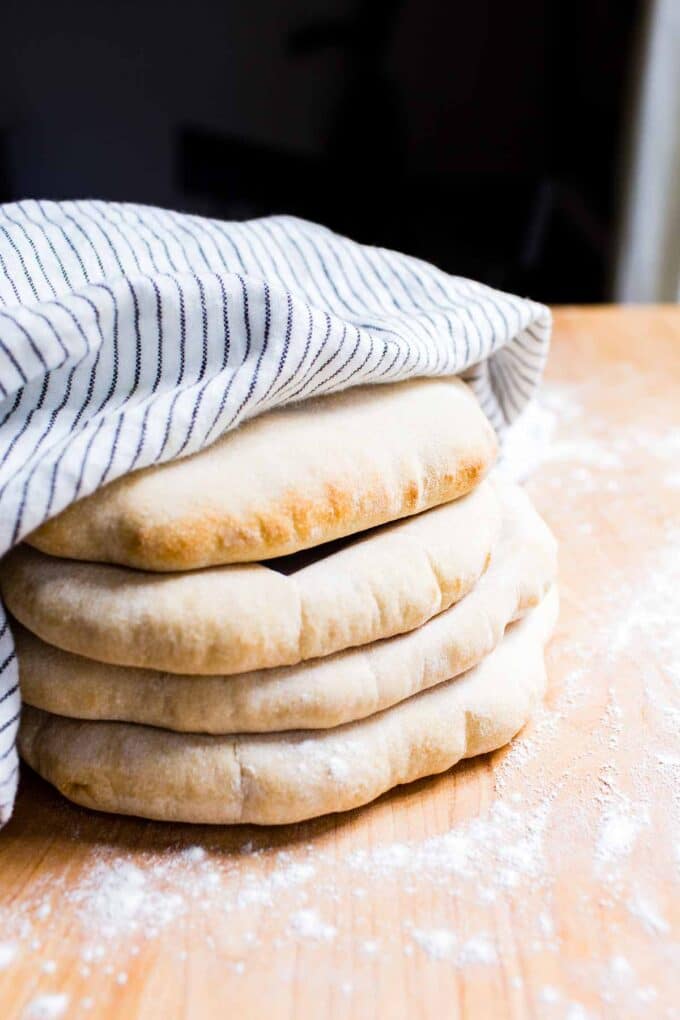
Expert Tips
- I include whole wheat flour in this recipe because it offers an earthy, rustic flavor and added nutrition. It can be replaced with bread flour if desired.
- Use stone ground whole wheat flour for flavor and nutrition!
- Weigh your ingredients for best outcome.
- Make sure your oven is fully preheated so that the pita will puff up as it should. An external oven thermometer is helpful in knowing the proper oven temperature. I recommend a digital oven thermometer with an air probe.
More Recipes with Sourdough Starter to Love
- Brioche-Style Sourdough Hamburger Buns
- Easy Sourdough Discard Biscuits
- Sourdough Vegan Pancakes
- Soft Sourdough Rolls
Soft and Puffy Sourdough Pita Bread
Ingredients
- 1 cup (200 grams) Sourdough Starter 100% hydration, active and doubled in size
- 3/4 cup + 2 tablespoons (200 grams) Warm Water 80 degrees Fahrenheit (27 Celsius)
- 2 tablespoons Maple Syrup or honey
- 2 tablespoons Extra Virgin Olive Oil
- 2 cups (300 grams) Bread Flour unbleached
- 1/2 cup (85 grams) Whole Wheat Flour stone ground
- 1 teaspoon (6 grams) Fine Sea Salt
Instructions
- Mix the Dough: In a large mixing bowl, add the sourdough starter, water, maple syrup, and olive oil. Whisk until there are no chunks of starter floating around. To the wet ingredients, add the bread flour, whole wheat flour and salt.
- First, mix with a fork, the dough will become shaggy. Then mix by hand, mixing, folding and pushing the dough until the flour is fully incorporated and no dry bits are present. It will seem dry at first, but the more you work the dough, the more hydrated it will become. Do this for about 3-4 minutes. The dough will stick to your fingers as you go.
- Use the fork to scrape off the dough on your fingers as much as you can. Cover bowl with a damp tea towel. Set a timer for for 30 minutes and allow the dough to rest for 30 minutes. Now is a good time to feed/refresh your starter.
- Fold the Dough: After the dough has rested, fold the dough. To do this, grab a portion of the dough while it remains in the bowl, stretch it up and fold it over, pressing your fingertips into the center of the dough. You'll notice the dough is less stiff and more workable at this point. Repeat, until you've worked your way around the dough. This is the first fold, and you can stop here and begin bulk fermentation, but If time permits, and optimally, you'll want to repeat this fold at least one more time, two if you can, as it improves the final dough's structure. Allow for about 30-45 minutes each between folds.
- Bulk (fermentation) Rise: After the last fold, cover the bowl with two damp towels and allow to rise overnight at room temperature. This will take about 10-12 hours at 70 degrees Fahrenheit (21 Celsius), but in a cooler kitchen the dough can take up to 12-16 hours to rise – this is the norm in my chilly kitchen. The dough is ready when it no longer looks dense, is jiggly when the bowl is shaken, and has about doubled in size.
- Shape the Dough: In the morning, and with damp fingertips, coax the dough into a floured work-surface. Divide the dough into 4 pieces (210 grams each). Working quickly, with a piece of dough on the work surface, pull the edges of each piece to the center to shape the dough, and pinch making a rough dough ball. Place the dough ball on the floured work surface pinched side down. Rest the dough for five minutes. Scrape the flour away from your work surface and sprits a touch of water. This will increase friction between the dough and surface if needed (otherwise the dough will slide around rather than grip the surface to form a tight ball). Gently cup your hand behind the dough ball and pull it towards you to increase surface tension. Once a ball is formed, proof the dough.
- Proof the Dough (second rise): Transfer the balls to a lightly floured surface, and cover with a damp tea towel. Allow the dough to rise at room temperature for 15 minutes (a quick proof). They'll become just slightly puffy.Meanwhile, preheat the oven to 500 degrees Fahrenheit (260 Celsius). Arrange the oven racks in the upper and bottom third of the oven. Place an upside down sheet pan(s) and/or pizza stone on each rack for preheating. Bake two at a time (two is easier to manage without cooling the oven down too much). I bake two at a time on one sheet pan. Or, one at a time on a stone.
- Roll Out the Dough Balls: On a lightly floured work surface, use a rolling pin to roll the dough balls into a uniform disk to between 1/8 – 1/4 inch (.3 – .6 centimeters) thick and 7 – 7 1/2 inches (17 – 19 centimeters) wide, turning the dough like pie dough to keep a circular shape, sprinkling with more flour as needed to prevent sticking. If the dough becomes difficult to roll, set it aside to rest for about five minutes, and roll another ball. Transfer the pita dough to a small piece of parchment paper. Cover with a damp tea towel unless transferring directly to the oven. Finish rolling out the remaining dough balls.
- Bake the Pita Bread: Once the oven is preheated, transfer the pita to a peel or upside down sheet pan. Open the oven door, and using the parchemnt as a handle, slide the pita onto the preheated stone or pan.Bake for 5 minutes and 20 seconds or until the pita is puffed up and only lightly golden on the bottom around the edges. It won't brown on top. No need to flip the pitas while they're baking.
- Remove from the oven and loosely wrap the pitas in a tea towel(s). Do not deflate the pitas while still hot as the steam coming out of the pita will burn skin. Rest 10 minutes, then gently deflate once cooled.Slice the pitas in half and enjoy stuffed, or slice into wedges for dipping in all the things (see blog post for ideas!).
- To Store: Sourdough is best consumed on the same day it's baked, but pita will last for 2-3 days stored at room temperature in a sealed plastic bag.Baked pita freezes beautifully. First, allow the pita to cool completely, then place in a freezer bag. Freeze for up to two weeks. Thaw at room temperature, and rewarm in a 350F oven, wrapped in foil (to keep their softness) for about 10 minutes.

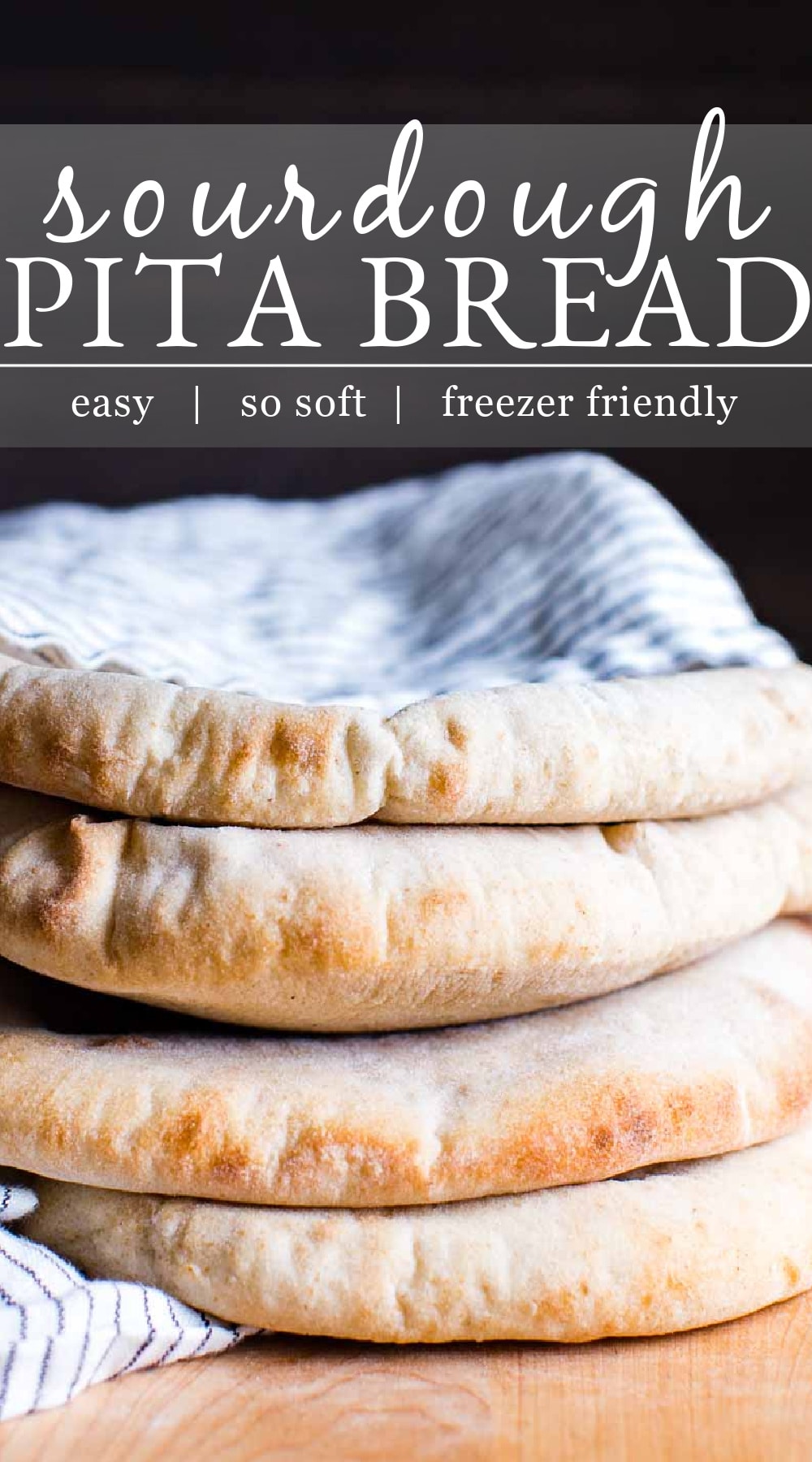

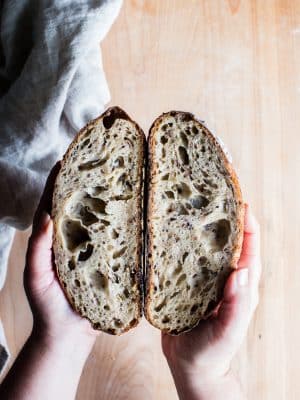
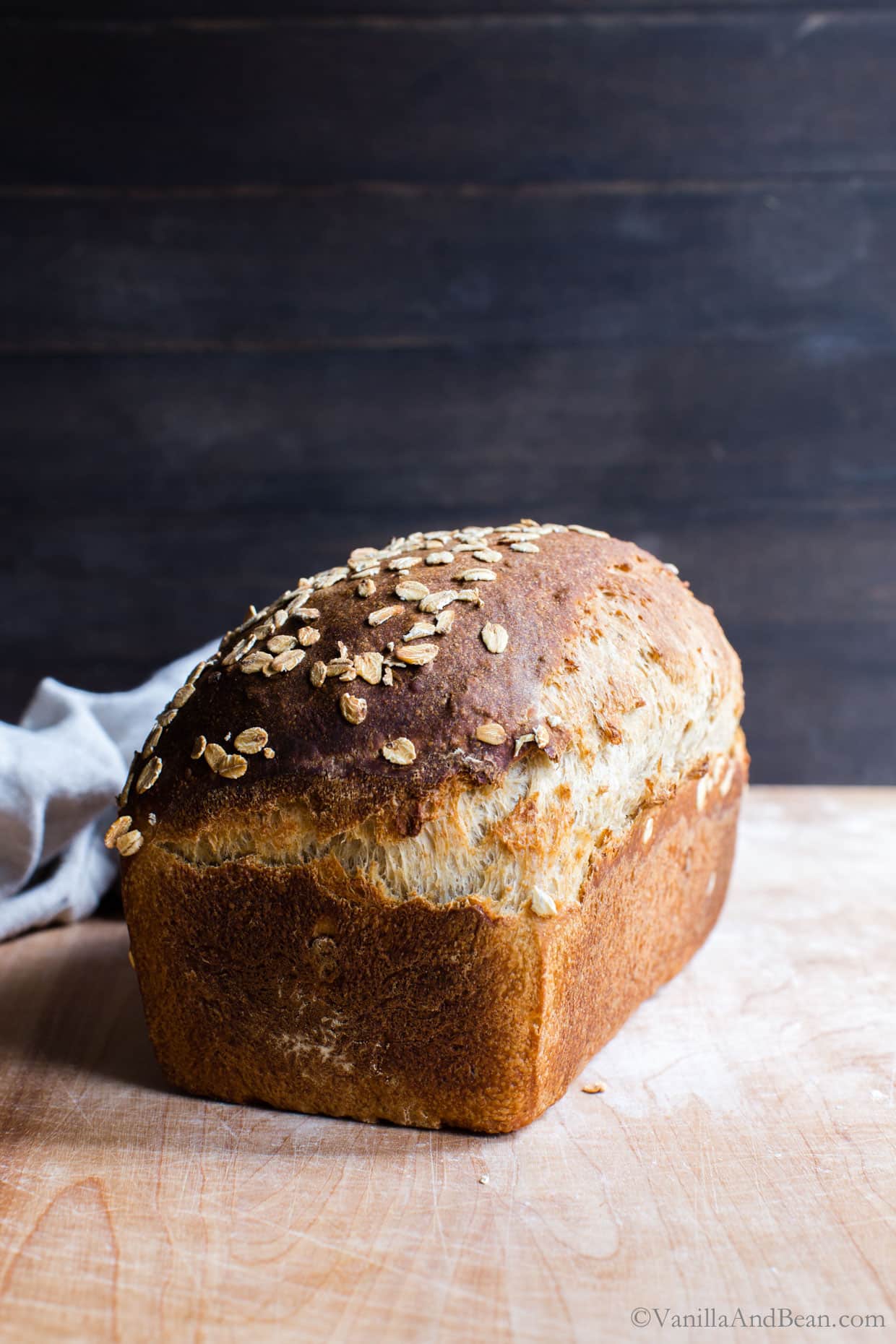

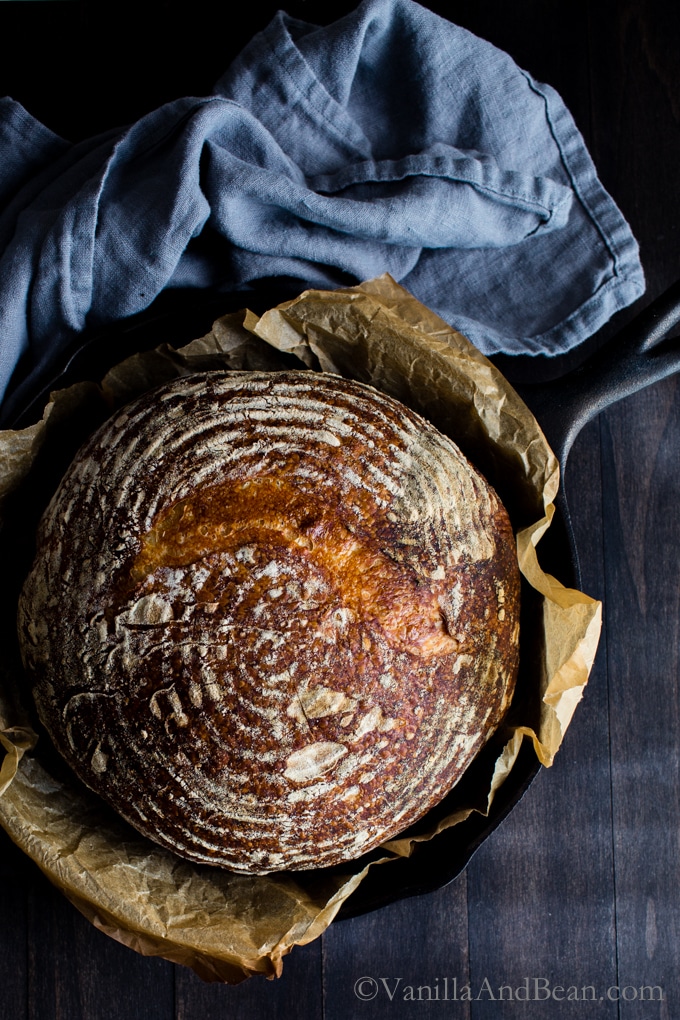
Pitas taste great. Maybe I did something wrong but only one of my pitas puffed up. The rest were flat. What did I do wrong?
Hi Gianna! So glad you’re enjoying the taste of the pita bread! Thank you for your note. First thing that comes to mind is oven temperature. If it’s not hot enough, the pitas won’t puff. Are you employing an external oven thermometer? Be sure the oven has time to recover to 500F before baking another pita.
I can’t say enough about this recipe. It’s perfect! This is the best pita I’ve ever had. So fulfilling to make at home. I made Diane Kochilas’ tzatziki with it. I’m in heaven. Thank you so much for sharing this. ♥️
Worked out perfectly! So soft and perfect puffy pillow.
Hi Wendy! Thank you for coming back and sharing your five star review! SO excited!
Are the calories per whole or half pita?
Hi Sarah! One pita pocket, so half a pita.
Awesome thank you!
This pita is seriously SO GOOD! I was a little worried about it not being cooked thoroughly, but it turned our PERFECT!
100/10
Fabulous recipe – these came out fluffy and delicious.
I love that you use weights rather than cups. I specifically look for bread recipes that use weights as they are more reliable. Thanks for sharing!
Buenos días, ref a su receta solo podría. comentar que por los ingredientes debe salir un pan buenísimo, voy a intentarlo. Tengo una pregunta yo uso masa madre de harina integral o de harina de centeno, como son 150 gr en la receta debo considerarla en la receta, solo tengo un poco de experiencia en hacer hogazas y normalmente llevan un porcentaje de harina de trigo integral o harina de centeno, entonces no soy muy cuidadoso en estos porcentajes. pero en este caso quisiera ser muy estricto en la receta con los ingredientes pretendo que me salga un pan muy bueno o bueno en general. gracias y saludos cordiales/Jdelao
Hola Jdelao… como no he usado ningún iniciador de masa madre que no sea uno con harina para todo uso, no sé cómo quedaría esta receta de otra manera. Dicho esto, debido a que el iniciador es un pequeño porcentaje de la masa total, siempre y cuando el iniciador esté 100% hidratado, no dudaría en intentarlo. Gracias por detenerte. Espero que esto ayude. ¡Háganos saber si lo intenta!
I’ve tried making sourdough pita bread about 3 times using a variety of recipes. None of them could compare to the texture and flavor of your recipe. They reminded me of the pitas I get from my local falafel restaurant. This was super simple to make and very flexible timing wise. I ended up having my pita balls sitting on the counter covered for over 8 hours after the 2nd proof due to a minor emergency that had me away from the house. I baked them when I got home and they were still perfect. I will definitely try this again without having them sit out for so long. Thanks for the recipe!
Hi Marisa! Thank you for your note, five star rating and giving the pita recipe a go! Hooray for a looong proof (so glad it worked and thank you for letting us know!) and a tasty, perfect pita!
Fantastic recipe, thank you! First time making pita bread and they were perfect! I threw the dough in the fridge after it had nearly doubled because I wasn’t ready to bake. Pulled it out a few hours later and worked with cold dough. They puffed up beautifully and tasted delicious! Definitely adding this recipe to my regulars. Thank you!
Hi Holli! Thank you for your note, review and sharing your cold ferment tip! So excited you’re enjoying the SD pita!
I’ve made this before and it is awesome. I need to take the dough after bulk ferment traveling & do the balls later. Timing is a problem. Can any of the long rise be done in the fridge or a cooler? I love this bread but don’t want to screw it up. Thank you!
Hi Bonnie! Thank you for your note and giving the pita a go… The long rise can be done in the fridge or a cooler. You’ll just want to make sure the dough doubles in size before you shape the pita balls. So, after you mix the dough, pop it in the fridge or cooler. I’ve done this before for up to 12 hours. Then, the dough will just need to double in size. I hope this helps and you enjoy the long fermentation (hello flavor!).
Thank you so much Traci. I will let you know how I do. Have a great day.
Excellent recipe! I made these tonight and my 5 year old triplets loved them AND helped roll them out. Seems to be forgiving enough;)
I made the dough this am and let it sit on my counter until this evening…probably a 7 hour ferment. Still turned out beautifully! Can’t wait to try them either the recommended bulk ferment.
Hi Chelsey! Super happy to read your note and that your littles helped. What fun! SO happy y’all are enjoying the pitas!
Until making this recipe, pita always = meh. Excellent! Another favorite.
Hooray for tasty Pita, Sheryl! Thank you for your note and giving the pita a go!!
Fantastic recipe. I’ve made it a few times now, best pita I’ve ever had. I prefer to make 8 instead of 4 out of the same dough, but that’s just my size preference.
Thank you for your note, Kelly and giving the pita a go! SO happy to receive your note and FIVE star rating!
So easy and so delicious. Made some hummus to go with it and blew my wife away. This is a keeper!
Day made, Jon! Super happy to receive your note and star rating!
Excellent pita recipe! Rose beautifully overnight, shaped well, and puffed like a whoopee cushion in the oven! I’m glad I doubled the recipe! Will be adding this to our recipe book. Thank you!
Hi Maggie! Super happy to receive your note :D Thank you for giving the pita a go and coming back to share your experience. I lol “like a whoopee cushion”! That is SUPER exciting when it comes to pita bread.
Hi Traci,
I’m just wondering if we need to degas before shaping? Thanks.
Hi Jennie! No need… when you divide and shape the dough, you’ll lose some of that gas! Keep us posted!
Thanks for replying so promptly. I’ll give it a try. Thank you so much.
This recipe was spot on Perfect.
Thank you!
Hi RJ!Thank you for coming back and leaving a note and rating. Super happy to hear!
well worth making these from scratch, it’s been so long since I’ve had a good pita, so thank you!
Hiii Sabrina! Thank youu for making and sharing! Day made 👏🏻❤️
Can you believe I’ve never made pita bread?!?! OMG I need to try ASAP. Looks so good and your instructions are so clear!
It’s time for homemade pita Liz! SO soft, fluffy and delicious.